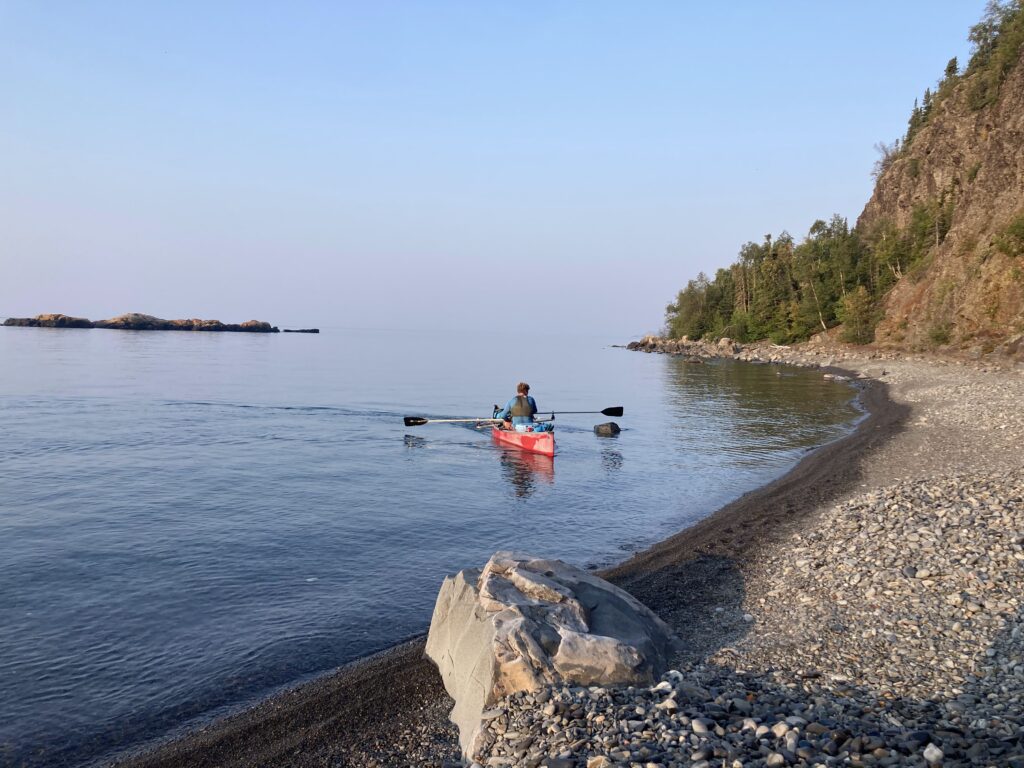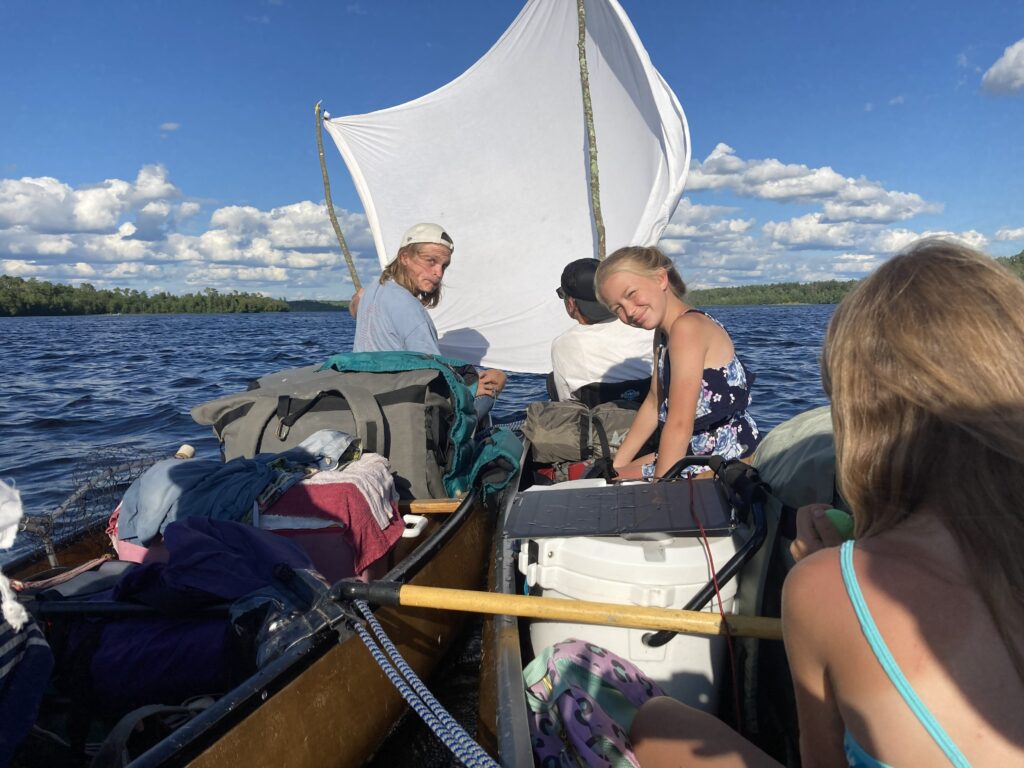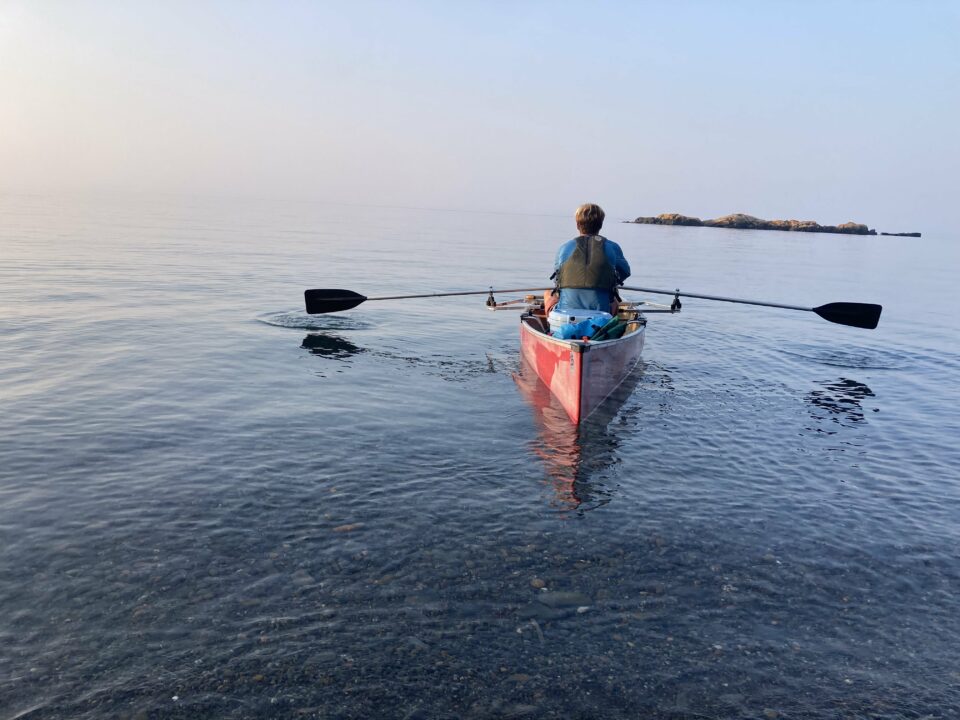Lake Superior looms before you, and you want to go explore it in your canoe. You’re hankering to go island hopping out of Thunder Bay, or check out the Apostles. Are you going to paddle out there? Not a chance. But there’s another way. Rowing your canoe is a faster, more powerful method of traveling long distances on big water. Rowing from a central position in the canoe also provides increased maneuverability and balance on bigger waves. Let’s see how to get started rowing, as well as cover some basics of two other low-tech methods of canoe propulsion: sailing and poling.
Rowing
Some people might not even have thought rowing a canoe is possible. But when they see it being done, all of a sudden they think “Oh, I would love to do that.” Rowing uses two blades rather than a single paddle. Longer oars keep the blades in the water for a greater distance, thus creating greater power. Having blades on both sides of the boat also gives the rower much greater stability, as the canoe can be steered from either side, or both sides, at once.
Chuck Newberg has been perfecting rowing units made by Spring Creek Manufacturing out of Mountain Iron, Minn., ever since his father founded the company in 1985. “If I’m on Lake Superior in a canoe, I’d be rowing, because you’ve got so much power. You time the waves, making your strokes when your blades can be fully immersed in the wave,” explains Newberg.
Spring Creek Manufacturing’s removeable rowing units can be attached to any canoe in seconds. It works particularly well at transforming tandem canoes into stable solo boats, as the weight and steering are both now centered in the canoe. Spring Creek’s canoe rowing unit includes three pieces: a drop-in seat that clamps to the inside of the canoe gunwales, rowing outriggers with bushings and oar pins that also clamp on the canoe, and the oars themselves. The kit is lightweight, stable, and made out of durable aluminum in Minnesota.
What are some more benefits of rowing? One rower can easily keep up with two paddlers, which will definitely make you the envy of your paddling friends. You can also turn on a dime when rowing. This can transform your tandem canoe into a great river float boat, as long as the river is deep enough for oars to be handled properly. When floating downriver, oars are used for making precision course adjustments that can provide critical help in strong current or around down trees. The river needs to be suitably wide, as the oars have a total wingspan of about 15 feet when mounted in the oarlocks.

Finally, there’s every canoeist’s nemesis – wind. How many times have you been paddling stern in a long canoe, and you just can’t turn the bow into the wind? It’s frustrating, and physically exhausting. If you’re paddling a tandem boat solo, the wind problem is even worse. Your ultimate solution is rowing. The longer oars and the rower’s central position using the drop-in seat give you the turning leverage you need to take on strong wind.
Grant Sega, Vice President of Spring Creek Manufacturing, says all of these factors make the rowing unit a way to gain independence for someone who has a tandem canoe: “You can solo it and get much more efficiently from point A to point B. Chuck and I have always said we put our money on one person rowing a tandem canoe much more effectively and efficiently than two people paddling a tandem canoe. It’s better balanced, and a lot more effective overall.”
Sailing
The horizon keeps calling you, but how are you going to paddle that far? Another way to explore big water in a canoe is by sailing, which can extend the distance one can travel by harnessing the wind.
One simple way to sail canoes, tested by many savvy Northwoods travelers, is to lash two canoes tightly together with rope (or with Spring Creek Manufacturing lashing bars), then hold two tree branches straight up at the bow seats, and tie a bedsheet between the two masts to create a sail. When the wind starts pushing the canoes, and you begin effortlessly traveling down the lake, you are enveloped by a feeling of rapture. This is propulsion using brains, not muscle.
Sailing was one of the earliest methods of canoe propulsion, and was used by islanders in Oceania and the Pacific islands with dugout canoes. Today, reconnecting to the low-tech simplicity of our predecessors provides a tremendous feeling of continuity with the past. Low-tech worked for them, and can still work now. Again, for easy canoe sailing you’ll need two canoes, and can only sail downwind.
For next-level canoe sailing you’ll want to tack into the wind. To achieve upwind sailing, you’ll need to attach leeboards to the outside of your canoe. Leeboards are fins in the water that reduce side slippage when sailing across or upwind. This means the canoe can move forward more, rather than sideways. One other key piece of equipment will be outrigger pontoons, which can be attached to the canoe to provide more stability when the canoe starts to heel.
For more inspiration and ideas for transforming your canoe into a sailboat, check out the Open Canoe Sailing Group on Facebook.

Poling
Perhaps the most low-tech method of all for canoe propulsion is to pole the canoe. Still in common practice today by folks harvesting wild rice, poling is a way of pushing off the bottom of the waterway you’re travelling with a long pole (tree branch). Think of poling when cross-country skiing, but here you’re pushing off of the river or lake bed, rather than the crusted snow.
Poling has been used by generations of indigenous North Americans for harvesting wild rice. Wild rice plants grow as very thick emergent grass, which prohibits paddling. Furthermore, paddling can damage the fragile rice plants. Since wild rice grows in water from 6 inches to 3 feet deep, it’s possible for a person to stand up in the canoe and “pole” the canoe along from their elevated position. It’s not fast, and it’s hard work, but poling is as low-tech as it gets.
According to the “Ojibwe People’s Dictionary” (ojibwe.lib.umn.edu/), a ricing pole is a lightweight wood pole of cedar or tamarack. The pole “has a forked end nailed to it made of sumac. The pole is used to propel a canoe when wild ricing in shallow, sandy or muddy waters. The fork is designed so as not to damage rice stalks when poling.”
It’s possible to craft your own push pole, which should be at least 10-12 feet in length. Classes on pole construction have been offered before at the North House Folk School in Grand Marais.
Finally, as per the MN DNR Wild Rice Regulations, “push poles used to propel watercraft for harvesting wild rice must be forked at the end. The forks must be less than 12 inches in length.”
Here again, poling a canoe provides an instant connection to local history and heritage.
Poles were also historically used by Ojibwe to pole up rivers through rapids. Accomplished polers could move a loaded canoe upriver without portaging. Today, canoe poling on rivers is all but a lost art form in the Midwest.
While paddling will ultimately be the simplest form of canoe propulsion for most to master, rowing, sailing, and poling all have their moments too. Try implementing these alternative low-tech methods for your own canoeing pleasure.




